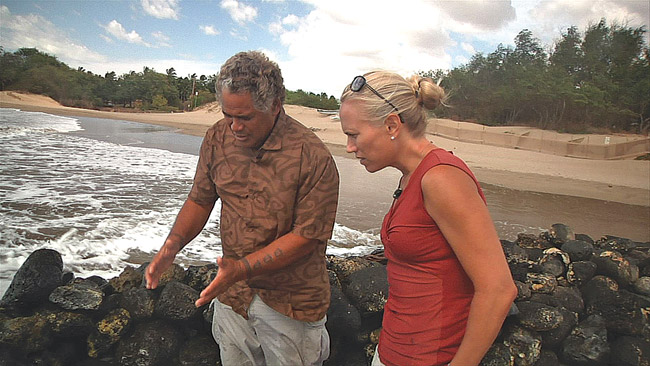A New ‘Voice Of The Sea’ On TV

Cultural expert Kimokeo Kapahulehua and Kanesa Duncan Seraphin discuss the restoration of a Hawaiian fishpond | Photo courtesy Voice of the Sea
Kanesa Duncan Seraphin has been a strong voice of the sea for much of her adult life. The world paddleboard champion has spent thousands of hours in the ocean chasing down waves on her way to winning the Molokai to Oahu paddleboard race eight times.
She’s also been an advocate of marine life in her role as a shark researcher, director of the University of Hawaii Sea Grant Center for Marine Science Education, and associate professor at the Curriculum Research and Development Group at UH-Manoa.
“I’ve accomplished much as a paddleboard professional, and I’ve done a number of different projects during my science career,” says the Canada native. “I’ve done work for National Geographic, to in-house stuff at UH. And I thought it was time to share some of those experiences and stories with a bigger audience.”
That time is now. Seraphin’s voice is even stronger these days, thanks to a different type of wave: the television airwaves. She is the host of a new program called Voice of the Sea, which premiered in January on KFVE.
“We want to show that science is not just about big fish and whales and sharks,” says Seraphin, who grew up in California and Colorado. “It is also about plankton, oceanographers, scientists and practitioners. It’s about people. We want to show it from a raw perspective.”
Seraphin says the show had been in the works for several years. She and her team received their first grant in 2010 and started filming in 2012.
“We had a couple of different ideas that we wanted to run with, and we went ahead with producing the program,” explains Seraphin, who studied ecology and biology at Cal Poly. “When we were happy with the direction we were heading, we showed some of the episodes to John Fink (of KFVE), and he was all for it. It’s a great partnership, and we have a great time slot being on the air at 6 p.m. on Sunday.”
Seraphin says they are committed to produce 19 new episodes a year (and 33 reruns) for at least two years and “maybe even a third year.” She hopes the show will inspire Hawaii’s youths to study ocean science and encourage students to pursue a career in science, technology, engineering and math (STEM) fields. Ultimately, she’d like her videos available online and to reach beyond classrooms.
“I’m excited about the quality of the product, and now we’re looking for ways to get people to watch it,” says Seraphin, who moved to Hawaii in 1999 and earned a master’s and Ph.D. in zoology at UH. “We know teachers can use it to some extent, but we want families to talk about the topics they hear on the show and maybe inspire students into science or education careers.”
Seraphin says another goal is to connect culture with science. She stresses the importance of providing a vehicle for people to express the environmental concerns of other places in the Pacific. To do so, she and her team traveled to America Samoa, Guam, Palau and even Tahiti. While there, they met with National Oceanic Atmospheric Administration (NOAA) scientists, who shared how locals connect and adapt to environmental and population changes.
“It’s been helpful to have contacts from both the paddling and science worlds,” says Seraphin, who, with husband Thor has two daughters. “I want people to try it out and watch it. I think they’ll be surprised how much they’ve learned and enjoyed the program, because the topics are interesting to just about everyone. We are really trying hard to make the show exciting and also make it real.”
For more, go to mse.seagrant.soest.hawaii.edu/voice-sea.
rkmizutani@gmail.com





